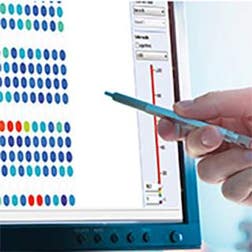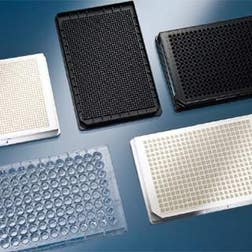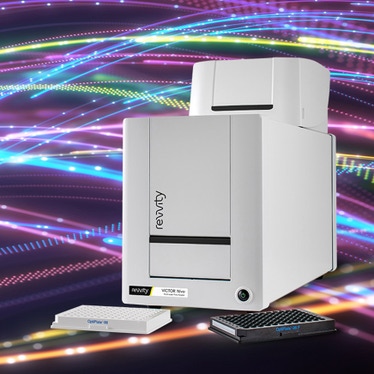Types of detection technologies
Absorbance
Well-established assay
Absorbance is the measurement between the amount of light being absorbed by a sample and the light that passes through the sample (non-absorbed). A specific wavelength of light is usually selected from an optical filter or the whole spectrum can be captured using a spectrometer. It is one of the most well-established microplate assay formats and perfect for assays such as ELISA, protein and nucleic acid quantification, and enzyme activity.
Alpha
Assay for virtually any application
Alpha is a high-performance laser-based technology, validated for use with our proprietary AlphaScreen™ and AlphaLISA™ assay kits. It has the power to assay the most complex samples – all in one well, with no wash steps. Alpha Technology enables fast, simple, highly sensitive detection of biomolecules in cell lysates, cell supernatants, serum, and a variety of other sample types. Laser-based Alpha detection allows you to have quick readouts, while maintaining a high signal-to-background ratio.
Luminescence
Ideal for reporter gene, cytotoxicity, and proliferation assays
Luminescence is the measurement of light emitted as a result of a chemical or biochemical reaction with no excitation energy. A luminescence assay is extremely useful as a detection platform because of its wide dynamic range, greater sensitivity than fluorescence technologies and lower interference than other detection options. Luminescence assay formats include glow and BRET, and flash or dual glow – perfect for applications such as reporter gene, cytotoxicity, and proliferation assays.
Fluorescence intensity
Popular light emission detection
Fluorescence Intensity is the measurement of light emitted from a molecule (fluorophore) at one wavelength and light excited at a shorter wavelength. It is one of the most popular detection modes, and there are innumerable fluorophores available for applications such as DNA or protein quantitation, reporter-gene expression, and protein binding.
Fluorescence polarization
Ideal detection for high throughput
Similar to Fluorescence Intensity, Fluorescence Polarization is based on the emission of light by an excited fluorophore. For this detection, samples are excited by polarized light using specific filters. It is generally applied to measure binding events between small and large molecules. Fluorescence Polarization is a homogeneous assay technology that’s ideal for high-throughput screening. Fluorescein is the commonly used fluorescent label and is suitable for typical applications such as receptor-ligand binding, protein interaction, or hapten immunoassays.
Time-resolved fluorescence
Enhanced sensitivity and dynamic range for immunoassays
Time-Resolved Fluorescence (TRF) uses fluorescent molecules, called lanthanides, that can emit light over long periods of time after excitation. Time-Resolved Fluorescence can help improve the sensitivity and dynamic range of your immunoassays, even when sample is at a premium or in low concentration. TRF detection, together with lanthanide-based DELFIA, LANCE Ultra, or HTRF chemistries, offers enhanced signal-to-background ratio, high sensitivity, wide dynamic range, superior stability, and excellent flexibility.
Featured products

VICTOR Nivo multimode microplate reader
VICTOR Nivo™ packs all the latest major detection technologies in the industry’s smallest benchtop footprint. The perfect microplate reader for everyday biochemical and cell-based assays. It measures at any wavelength, with top and bottom reading for most standard technologies. With its ease of use software and remote access from almost any device, it is ideal for multiuser environments.
- Smallest and most affordable multimode plate reader in the industry
- Certified for use with HTRF™ technology
- Best for research labs with multi-users and low-throughput assays
VICTOR Nivo™ packs all the latest major detection technologies in the industry’s smallest benchtop footprint. The perfect microplate reader for everyday biochemical and cell-based assays. It measures at any wavelength, with top and bottom reading for most standard technologies. With its ease of use software and remote access from almost any device, it is ideal for multiuser environments.
- Smallest and most affordable multimode plate reader in the industry
- Certified for use with HTRF™ technology
- Best for research labs with multi-users and low-throughput assays

EnVision XCite multimode microplate reader
The EnVision™ XCite multimode plate reader provides exceptional sensitivity across all detection technologies, while keeping you flexible with both filter and monochromator based options plus full upgradeability.
And, the Enhanced Security software option includes tools to facilitate 21 CFR Part 11 compliance for integration into regulated environments (GxP).
The EnVision™ XCite multimode plate reader provides exceptional sensitivity across all detection technologies, while keeping you flexible with both filter and monochromator based options plus full upgradeability.
And, the Enhanced Security software option includes tools to facilitate 21 CFR Part 11 compliance for integration into regulated environments (GxP).

EnVision Nexus multimode microplate reader
For more than twenty years, our EnVision plate reader has been the proven leader in high-throughput screening - and the EnVision Nexus™ is the next generation of superior detection. It operates on a brand-new innovative platform that fast tracks your research, delivering the speed and accuracy you need for your most demanding applications. The EnVision Nexus multimode plate reader continues to deliver optimal results from our Alpha, HTRF™, LANCE™, and DELFIA™ assay technologies.
For more than twenty years, our EnVision plate reader has been the proven leader in high-throughput screening - and the EnVision Nexus™ is the next generation of superior detection. It operates on a brand-new innovative platform that fast tracks your research, delivering the speed and accuracy you need for your most demanding applications. The EnVision Nexus multimode plate reader continues to deliver optimal results from our Alpha, HTRF™, LANCE™, and DELFIA™ assay technologies.
Configurable key features for our multimode plate readers
|
VICTOR Nivo |
EnVision XCite |
EnVision Nexus |
|
|---|---|---|---|
| Absorbance | Filter or spectrometer | Filter and quad monochromators | Filter |
| Fluorescence intensity | Filter | Filter and quad monochromators | Filter |
| Luminescence | •1 | •1 | •1 |
| Ultrasensitive luminescence | • | • | |
| TRF and TR-FRET | Lamp based2 | Lamp or laser based2 | Lamp or laser based2 |
| Fluorescence polarization | • | • | • |
| Alpha (laser-based) | Standard Alpha | Standard or HTS Alpha | Enhanced Alpha and/or HTS Alpha |
| AlphaPlex (laser-based) | • | • | • |
| Dual PMT detector | • |
1 - Capable of BRET/BRET2 assays.
2 - HTRF™ certified.
|
VICTOR Nivo |
EnVision XCite |
EnVision Nexus |
|
|---|---|---|---|
| Absorbance | Filter or spectrometer | Filter and quad monochromators | Filter |
| Fluorescence intensity | Filter | Filter and quad monochromators | Filter |
| Luminescence | •1 | •1 | •1 |
| Ultrasensitive luminescence | • | • | |
| TRF and TR-FRET | Lamp based2 | Lamp or laser based2 | Lamp or laser based2 |
| Fluorescence polarization | • | • | • |
| Alpha (laser-based) | Standard Alpha | Standard or HTS Alpha | Enhanced Alpha and/or HTS Alpha |
| AlphaPlex (laser-based) | • | • | • |
| Dual PMT detector | • |
1 - Capable of BRET/BRET2 assays.
2 - HTRF™ certified.

Drug discovery reagents
Drug discovery is a time-consuming and costly undertaking. From understanding pathways to target identification and then to hit and eventually compound, the transition needs to happen quickly and efficiently. Our drug discovery reagents help you do just that. Whether you are studying basic science to uncover pathways and learn more about disease states or screening for potential leads, we offer a wide range of validated reagents and kits in Alpha chemiluminescent, LANCE Ultra TR-FRET, DELFIA TRF, and other assay technologies to suit your assay needs. Together with our multimode microplate readers, they can provide relevant and reliable results to accelerate your drug discovery.
Drug discovery is a time-consuming and costly undertaking. From understanding pathways to target identification and then to hit and eventually compound, the transition needs to happen quickly and efficiently. Our drug discovery reagents help you do just that. Whether you are studying basic science to uncover pathways and learn more about disease states or screening for potential leads, we offer a wide range of validated reagents and kits in Alpha chemiluminescent, LANCE Ultra TR-FRET, DELFIA TRF, and other assay technologies to suit your assay needs. Together with our multimode microplate readers, they can provide relevant and reliable results to accelerate your drug discovery.

Microplates
A microplate is a critical part of your discovery process. Microplates have the capability to generate valuable, information-rich data that bring great insights into discovery screening.
Microplate planarity and inaccurate data collection are common issues caused by microplates that are not carefully designed for the unique challenges of sample screening which can result in missed data points, sample re-screening, missed project timelines, and ultimately higher costs.
A microplate is a critical part of your discovery process. Microplates have the capability to generate valuable, information-rich data that bring great insights into discovery screening.
Microplate planarity and inaccurate data collection are common issues caused by microplates that are not carefully designed for the unique challenges of sample screening which can result in missed data points, sample re-screening, missed project timelines, and ultimately higher costs.

































